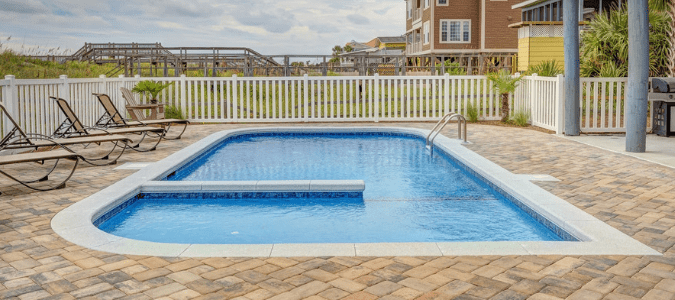If you look forward to swimming in your own backyard oasis, as the winter months come to a close, your thoughts probably turn to when to open your pool. While that’s not always the case for every pool owner, winter can be painful for those of us who like to spend time outdoors, especially in those parts of the country where we are used to sunshine and short sleeves nearly year-round. Here in Texas, most of us open our pools for the season when the temperature is consistently above 70 degrees. Since we can have some strange cold fronts some years, that can be in mid-March some years and not until early April in others.
Before we know it, we will be lounging poolside, dipping our toes in refreshing, crystal-clear water and enjoying warmer weather. Until that time comes, you may be wondering how to clean a swimming pool after winter, which opening pool chemicals to use or even strategies for opening a pool after winter algae.
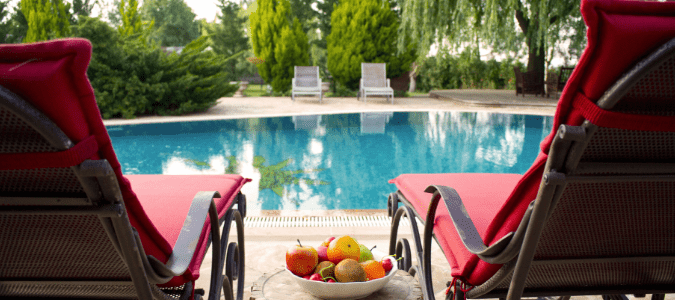
How To Clean A Swimming Pool After Winter
How to winterize your pool if you live in Texas or another southern state may be completely different from closing your pool if you live in a colder climate. Some homeowners keep their pools open all year long, and others choose to remove drain plugs, lower the water line to be even with the bottom of their tile and put on a cover to minimize the debris that can fall into the water. Having a pool cover also offers peace of mind that a young child won’t accidentally fall in unsupervised.
If you do decide to completely close your pool for the winter, an experienced pool technician will probably advise you to also consider installing a freeze guard or switch, checking to make sure automated valves are working correctly and making sure your heater is working. While you’re at it, you’ll probably want to make sure there are no combustible materials near your heater that could catch fire, including sticks or leaves.
Chances are that whether you closed your pool completely when swimming season ended or you just stopped swimming, debris has collected and the pool isn’t as clean as you’d like it to be. Along with the other steps to open your pool, which we review in detail below, you’ll want to add a preventative product to eliminate calcium build-up and other materials that can cause staining and discoloration. You’ll then want to turn on your circulation and filtration systems so that the cleaning solution reaches all the parts of your pool. After a few hours, and once you have readjusted your pool chemicals, you’ll want to give your pool a thorough brushing and vacuuming. When you do so, you’ll probably have to spend extra time in common problem areas, including near your steps, ladders and other equipment.
Now that we’ve gone over the basics of how to keep your pool looking cleaner, let’s go over the complete list of things you can do if you choose to completely shut down your pool during the winter months.
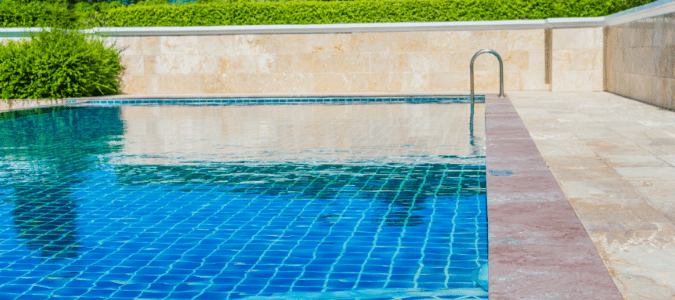
How To Open A Swimming Pool
Those of you who live in Texas who winterize your pool have a little bit more work ahead of you before you can start swimming. We’ve listed the steps involved in opening your pool when the temperatures permit.
Clean And Remove Your Pool Cover
Why would you need to clean the cover that was protecting your pool? Can’t you just lift it up like a blanket and be done with it? An experienced pool technician will tell you that you need to drain as much water as possible from the cover to decrease the amount of debris floating underneath. The easiest way to clean your pool cover is to place a cover pump on top and turn it on. Or, you can simply sweep or blow leaves off your cover to remove these materials that have accumulated over time. Once you fold your cover neatly, you can store it in a cool, dry place.
Raise The Water Level Back to Normal Height
Grab your hose and fill the water level in your pool back to its normal height. If you’re unsure what the “normal height” is for your pool, it’s usually around the middle of the skimmer opening or halfway up the tile.
Reconnect Unplugged Pool Equipment
If you prepared your swimming pool for winter, meaning you blew out the pipes and installed winterizing plugs to prevent water from getting back into them and freezing, then you’ll need to reconnect all of this equipment. Then reinstall each normal drain plug.
Don’t forget to take out all of the winterizing plugs from your pool equipment. This includes your pump, filter, heater, booster pump and pool cleaners. Afterward, reinstall each normal drain plug.
Wait until after the antifreeze has been completely discharged before removing the winterizing plugs from your skimmer and return lines. Then reconnect any return valve fittings that were removed last winter.
Turn Pool Equipment Back On
At this point, you should start turning on most of your pool equipment. So prime the pump and switch on the circulation and filtration system. If you have an air relief valve on your filter, open that so air can circulate out of that system.
Add Anti-Stain Solution
If water has been sitting in your pool for a couple of months, then you have a good chance of finding surface stains along the sides of your pool. We suggest adding a stain-removal product to prevent metals like copper or iron from building up in your pool. It’s best to use one liter of product for every 20,000 gallons of water to prevent this discoloration. Once added, wait at least two hours after you turn on your circulation and filtration for these materials to do their job.
Check And Adjust Your Pool Chemistry
After your circulation system has run for several hours and your pool is clean, you’ll want to test your pool water for pH, alkalinity and chlorine levels. Ideal readings for these chemicals should be between 7.4 and 7.6 for pH, between 80 to 120 ppm for alkalinity and 2.0 to 4.0 ppm for chlorine.
Adjusting your pool chemistry ensures your water is safe and comfortable for your swimmers. If alkalinity levels are too high, use a dry acid or sodium bisulfate to lower the pH and maintain balanced water. Dry acid and sodium bisulfates are a granular form of acid that quickly dissolve in swimming pools. Add 1 ½ pounds of dry acid for every 10,00 gallons of water to lower the total alkalinity by 10 ppm.
Sodium bicarbonates work in the opposite way as dry acid and sodium bisulfates; they increase total alkalinity. Adding 1 ½ pounds of sodium bicarbonates will increase total alkalinity by 10 ppm if added into 10,000 gallons of water. The healthy range for alkalinity is somewhere between 80-120 ppm.
Any pool that has a pH level exceeding 7.6 needs to be adjusted immediately, because this means your pool water is too soft, which can cause red eyes and dry skin. If your pH is somewhere between 7.4 and 7.6, you can add two cups of dry acid to your water every two hours to lower your reading, only adding more product when needed.
Granular soda ash can be applied if you need to raise your pool’s pH levels. If your pH level is below 7.4, adding six ounces of soda ash will increase the pH level of 10,000 gallons of water by 0.2 ppm. After adding soda ash, wait four hours with the circulation system running and then retest the water once more. Add more granular soda ash when needed.
Homeowners can determine if their pool’s calcium levels are uneven if the water is cloudy and murky. These conditions usually indicate that calcium levels are high. Water your calcium levels are too low, your plaster can degrade. In a vinyl or fiberglass pool, low calcium levels can even lead to damage to your metal fittings.
Calcium hardness should always be above 150 ppm and below 400 ppm. The best way to raise your calcium levels is with a hardness increaser. Unfortunately, there is no easy solution for reducing calcium hardness; however, dilute your water to reduce your calcium levels.
To prevent calcium hardness from becoming a recurring problem, you’ll need a sequestering agent, otherwise known as a compound that, when added to water, will chemically bond with calcium and other minerals to make them more soluble. With a sequestering agent, calcium will still be in your pool but in a form much less likely to cloud or form scale if the pH or other factors get out of balance.
Brush And Vacuum
Just because you’ve adjusted and balanced your pool’s chemistry doesn’t mean there won’t be dirt or debris still floating within the bottom of your pool. Use your brush and vacuum to remove lingering grime or dirt lurking on the pool steps, ladders, filters or other equipment.
Run The Filtration System
How does your pool maintain that beautiful, crystal-clear water? Your filtration system is responsible for removing debris, dirt, algae and bacteria from your pool. You’ll need to make sure your filtration system is up and in working order before swim season begins.
Shock Your Pool
“Shocking” the pool eliminates all of the remaining bacteria and contaminants left behind in your water during the colder season. To shock your pool, you first need to decide if you plan to use chlorine or non-chlorine treatments. A non-chlorine shock can typically be added directly to your pool water at any time, requiring you to wait just 15 minutes before you can safely swim again.
You can perform chlorine shocks with calcium hypochlorite, lithium hypochlorite and dichlor.
Calcium hypochlorite is one of the most inexpensive products to use to shock your pool. This convenient option contains 65-75% chlorine and adds about 0.8 ppm of calcium to your water for every ppm of free chlorine added, meaning you should proceed with caution if your water source already has a high level of calcium. Calcium hypochlorite also must be dissolved before being added into the pool. Unlike the non-chlorine treatments, the chlorine requires an eight hour waiting period until you can get back into your pool.
Lithium hypochlorite is best suited for swimming pools with a high calcium level. This fast-dissolver is a bit more expensive, but can be added directly to your pool without dissolving beforehand. Commercial versions of lithium hypochlorite contain 35% chlorine and can be toxic to aquatic life. Treating your water with lithium hypochlorite also means you won’t be able to swim in your pool for another eight hours.
Dichlor is the final chlorine shock that, depending on the brand, can be added to the pool’s water without needing to be dissolved beforehand. This pool cleansing agent contains between 50% and 60% chlorine and can be used for both regular doses or shock treatments. Each dose adds 0.9 ppm of cyanuric acid for every ppm of additional free chlorine and requires homeowners to wait at least eight hours before entering their pool again.
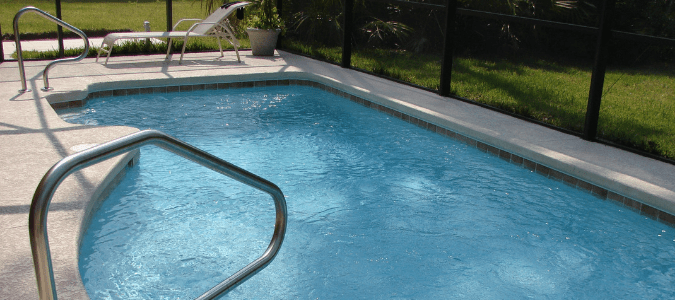
Opening Pool Chemicals
Opening pool chemicals have multiple purposes, such as balancing your pool water’s pH level, total alkalinity and calcium hardness. Opening pool chemicals can also serve as a stabilizer and sanitizer.
Keep in mind that before adding any chemicals to your pool, check your current levels. After you’ve opened your pool, try to test and review the pH levels weekly.
If you’re unsure of what numbers to be looking for after you’ve dipped your testing strips into the water, use the following numbers as a guide:
- pH: between 7.2 and 7.6
- Alkalinity: between 80 and 120 ppm
- Calcium hardness: between 180 and 220 ppm
- Chlorine: between 1 and 3 ppm
- Bromie: between 3 and 5 ppm
- Cyanuric acid: between 30 and 50 ppm
Now that you’ve tested your pool, you’re ready to add in the opening pool chemicals. You’ll probably want to start with clarifier and anti-stain chemicals. These products remove any dull particles from the pool’s surface and prevent stains, rust or scales from accumulating.
You may also need to add chemicals to keep algae from growing in your pool. These products are known as algaecides, and they work by eliminating most of the oxygen from the water that algae need to survive. Distributing algaecide will not only kill any existing algae but will also prevent any new growth.
The other critical opening pool chemical is high-quality chlorine to shock your pool. While “shocking your pool” might sound involved, as we mentioned above, it really just ensures that the “free chlorine” levels reach a point where you can quickly destroy contaminants. When opening your pool, it’s important to use double the amount of chlorine throughout the shocking process, as there is going to be more build up than you would find in a routine maintenance procedure.
Many home improvement stores provide pool opening kits that have all of the needed chemicals stored in one convenient box. Shoppers often appreciate the convenience of these kits because they eliminate having to measure the different products.
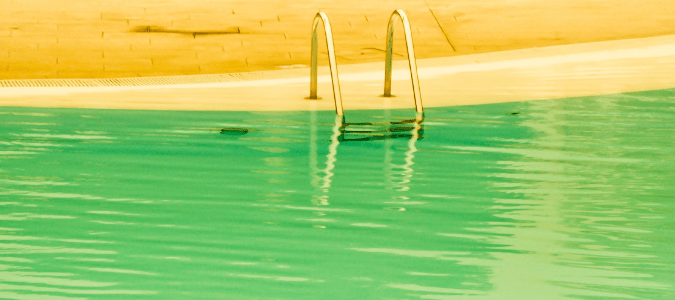
Opening A Pool After Winter Algae
Algae thrive in stagnant water with little chlorine, which often describes the conditions in our pools during the winter months. This means a healthy amount of algae can accumulate during the off-season.
Needless to say, you don’t want algae making your pool water green, clogging your filters or backing up your skimmers. The easiest way to protect your pool from algae growth is shocking the pool. If you have never done this before, we’ll review the steps involved.
Wipe Pool Walls and Floors
Brush away any pieces of algae you can find caked on the floor or trapped behind the ladder or steps. Steel brushes work best on concrete surfaces, while nylon brushes are better for vinyl pools. When brushing your pool surfaces, try to wearing clothing that won’t allow any exposed skin.
Adjust The pH
If your pH is above 7.6, which is common during an algae bloom, add a pH reducer. Your pH levels should be between 7.6 and 7.8 to prevent algae growth. After a couple of hours, test the waters again; if the pH levels have a normal reading but the total alkalinity is above 120 ppm, then we recommend following the instructions on your pH reducer label to bring your total alkalinity down between 80 and 120 ppm.
Find Your Chlorine Shock Product
Now that the pool’s stabilized, it’s time to choose a chlorine shock product. Try to select chlorine made with sodium hypochlorite, calcium hypochlorite or lithium hypochlorite. Remember that hypochlorite products are both flammable and explosive, while calcium hypochlorite should be avoided if you have hard water.
When you’re ready to shock your pool, make sure to add double the dosage of chlorine to eliminate algae. You may even need to triple the amount if your water is extremely murky.
Re-Examine Chlorine Levels
Once your pool filter had been running between 12 and 24 hours, it’s time to retest your chlorine level. If the water is between two and five ppm, but you still see algae, keep maintaining these levels as usual for the next couple days. If chlorine levels are below two ppm, shock your pool for the second time in the evening.
Keep in mind that your pool may have too much cyanuric acid if there was no significant change in chlorine levels. An overabundance of cyanuric acid often stems from treating your pool with granulated or tablet chlorine, which can morph chlorine into unusable forms.
Wipe Walls And Floors Daily
Brush and test your pool daily over the next few days to confirm that the chlorine and pH levels are within the recommended range. A healthy pool should be between two and four ppm of chlorine, 7.2 and 7.6 pH, 80 to 120 ppm alkalinity and 200 and 400 ppm for calcium hardness.
Vacuum Algae And Clean Pool Filter
Finally, vacuum any remaining dead algae and clean your pool’s filter. Paper filters should be replaced routinely. Once you get your water crystal clear again, celebrate your accomplishments with a nice long dip in the pool.
ABC Can Maintain Your Pool
Pool owners know that opening and closing a pool can be a lot of work. Instead of spending hours measuring chlorine and checking (and re-checking) pH levels, let ABC Home & Commercial Services take care of your pool maintenance. With ABC’s help, you can keep your pool looking great and ready for swimming, any time the temperature allows.
